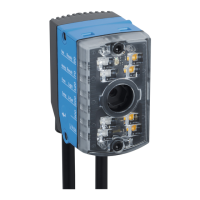
Do you have a question about the SICK Lector61x and is the answer not in the manual?
| Enclosure Rating | IP65 |
|---|---|
| Barcode Types | 1D and 2D codes |
| Interface | Ethernet, RS-232, USB |
| Operating Temperature | 0°C to 50°C |
| Storage Temperature | -20°C to 70°C |
Provides essential information on using SICK AG devices and prerequisites for safe work.
Defines signal words and symbols used to indicate hazards and provide notes.
Lists resources for more product details like data sheets, CAD files, and other publications.
Details the Lector61x's suitability for automatic stationary identification and decoding of codes.
Defines incorrect use and lists prohibited applications or environments for the device.
Discusses monitoring and maintaining a cybersecurity concept for product security.
Manufacturer's disclaimer for damages arising from non-adherence to documentation or incorrect use.
Warns that unauthorized modifications can lead to dangers and void warranty claims.
Lists qualifications needed for mounting, installation, commissioning, and operation.
Details risks from visible radiation, hot surfaces, and electrical hazards.
Lists components included with the product, like the device, protective cap, and focus tool.
Explains the type label and its role in product identification.
Details the information found on the product's type label for identification.
Explains the structure of the product's type code and its characteristics.
Provides a general overview of the device, including its main components and connections.
Describes the illumination unit, including LEDs and alignment aids.
Details the status LEDs, function button, and their roles in product operation.
Explains how working distance and field of view are determined and measured.
Describes manual and automatic methods for adjusting the product's focus position.
Covers handling, unpacking, and inspecting the product during transport.
Details procedures for safely unpacking the device to prevent damage.
Outlines steps for checking the delivery for completeness and transit damage.
Provides recommendations for storing the device to maintain its condition.
General guidelines for installing the device, considering environmental factors and heat dissipation.
Explains how to determine the optimal mounting position and orientation for the device.
Guides on setting the device's alignment for maximum field of view.
Details considerations for mounting angle to avoid reflections and optimize performance.
Details manual focus adjustment using the focus tool and its limitations.
Provides instructions and precautions for physically attaching the device to a mounting system.
Outlines prerequisites for mounting an optional trigger sensor for read cycles.
General guidelines and precautions for connecting the device's electrical components.
Provides guidance on layout, screening, and EMC compliance for data cables.
Details critical safety measures, grounding, and wiring practices.
Illustrates various connection schematics for the device and its modules.
Shows the connection diagram for initial commissioning and service mode.
Illustrates the connection principle for the device's read mode operation.
Presents typical scenarios and configurations for connecting the device.
Details the pin configurations for the device's connectors.
Covers connecting the device using various modules and supply voltage requirements.
Explains how to connect the device via specific connection modules.
Details requirements and specifications for connecting the device's power supply.
Explains how to connect Ethernet and serial RS-232 data interfaces.
Details the process for wiring the device's CAN interface.
Describes how to connect the device's digital inputs, including PNP sensor configurations.
Explains how to wire the device's digital outputs for signaling events.
Guides on installing and starting the SOPAS ET software for device configuration.
Details manual and automatic configuration steps using SOPAS ET.
Describes manual configuration steps within SOPAS ET.
Steps for making additional settings and testing during operational use.
Procedures for saving the parameter set permanently in the product or PC.
Explains how to manually configure the device using its function buttons and LEDs.
Describes how to save product parameters internally and externally.
Provides procedures for backing up configuration data to a computer.
Outlines preventive maintenance tasks required for the device based on its environment.
Details how to clean the device's housing and viewing window safely and effectively.
Lists common issues, their causes, and corrective actions for troubleshooting.
Explains how to access and interpret the device's error status log.
Outlines procedures for device repair.
Outlines procedures for returning products for service.
Provides step-by-step instructions for replacing the device, including data transfer.
Gives guidelines for environmentally friendly disposal of the device.
Lists key features and specifications for Lector610 and Lector611 models.
Details the device's mechanical and electronic specifications, materials, and ratings.
Provides detailed drawings showing the device's physical dimensions and mounting holes.
Lists specifications related to code reading performance, resolution, and evaluation time.
Details supported communication protocols and interfaces like Ethernet, RS-232, and CAN.
Specifies environmental conditions such as operating temperature, humidity, and EMC immunity.
Presents data on the device's perceived field of view at different working distances.
Information on how to download product conformity certificates and declarations.
Details pin assignments and wire colors for various connection cables.
Covers connecting the device to the CDB650-204 module, including wiring overviews.
Details connecting the device to the CDM420-0006 module, including wiring overviews.
Information on software licenses used by the product.